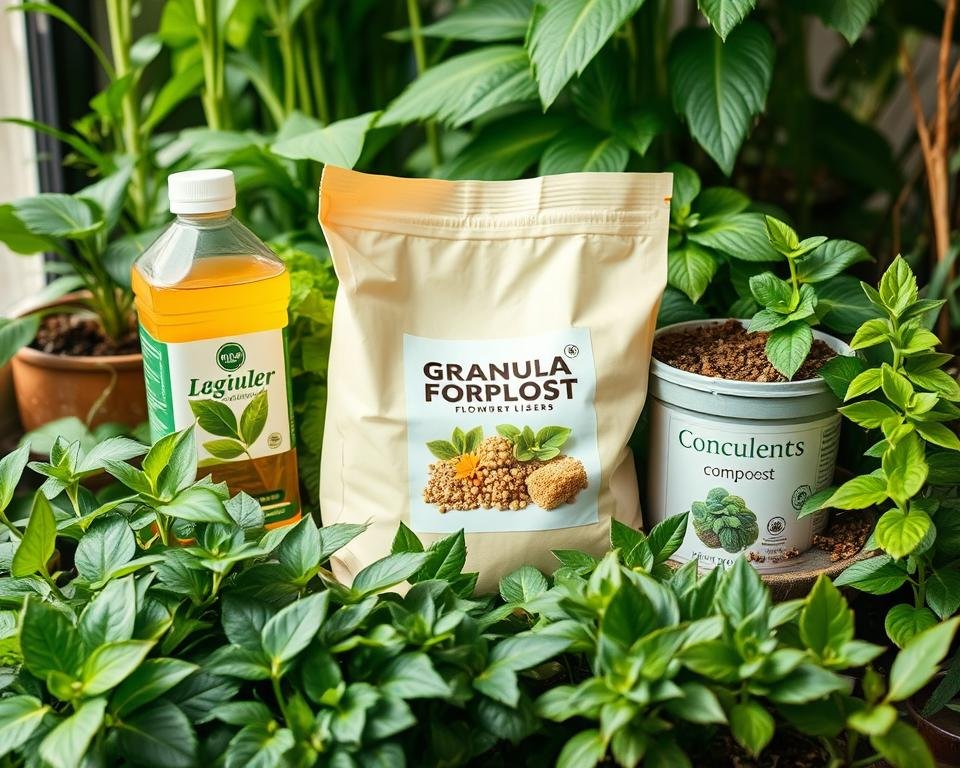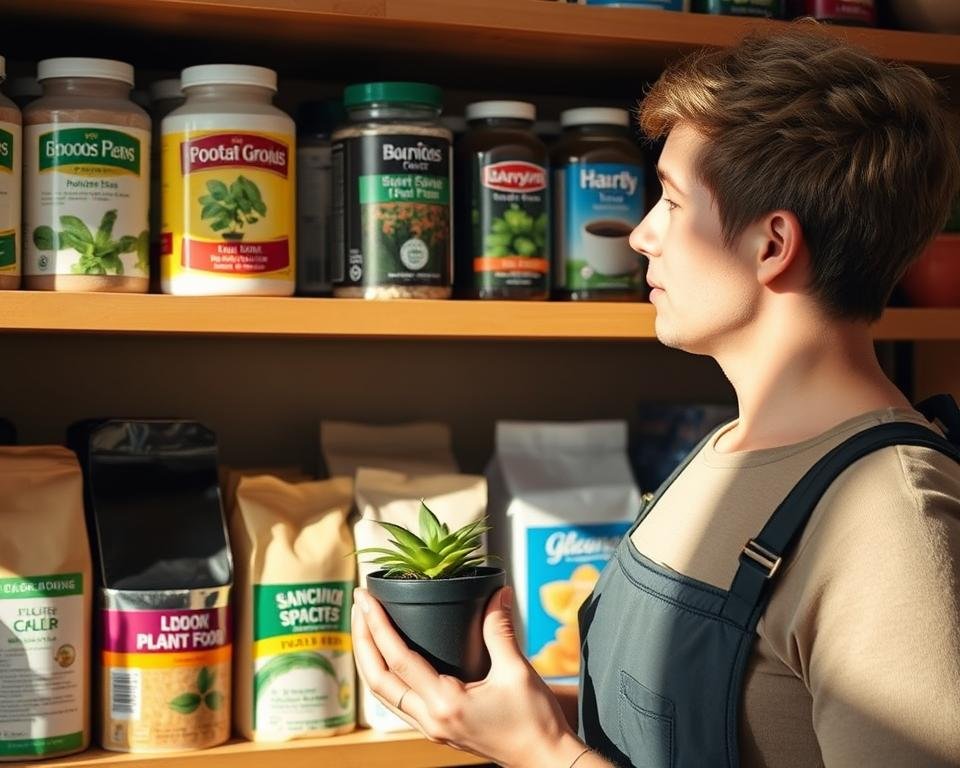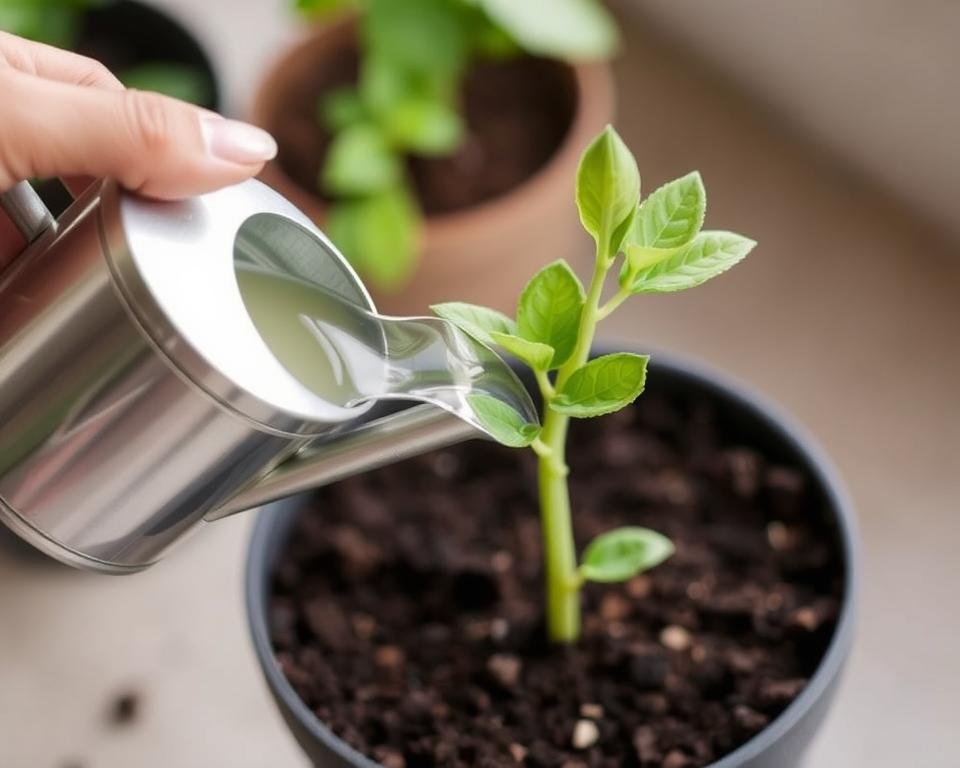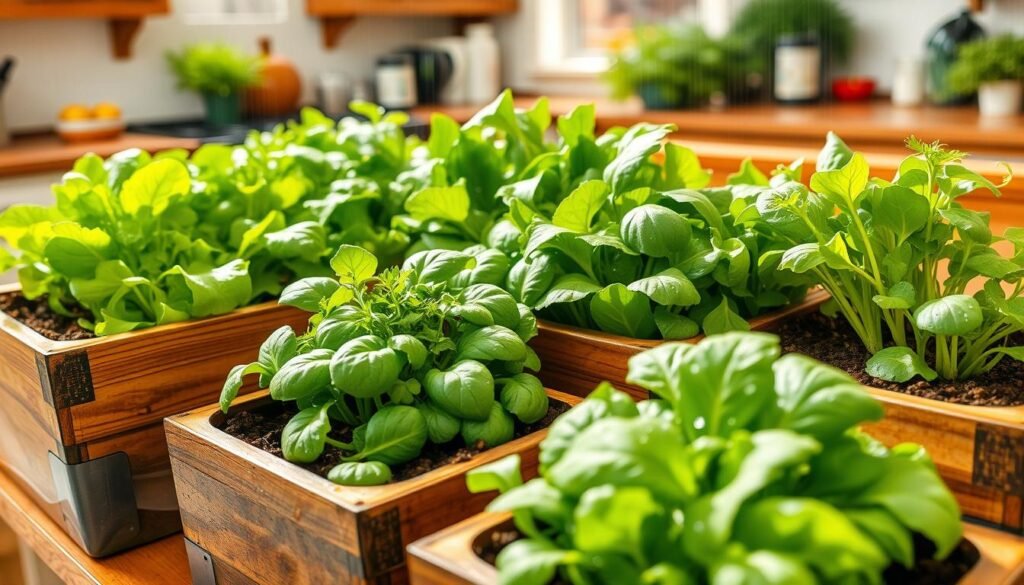Are you unknowingly stunting your indoor plants’ potential by overlooking the power of indoor plant food? It’s key to know how to feed your plants right to make them flourish. This guide will show you the importance of premium indoor plant food for your plants to stay healthy and bright. It’s essential whether you’re new to indoor gardening or have been doing it for years.
What Is Indoor Plant Food?
Indoor plant food is a special kind of fertilizer for houseplants. It has important nutrients like nitrogen, phosphorus, and potassium. These nutrients help indoor plants grow and stay healthy.
There are many types of indoor plant fertilizers to choose from. You can find liquid, granular, and slow-release options. Each type has its own benefits, so you can pick the best one for your plants.
It’s important to pick the right indoor plant food for your plants. The right fertilizer gives plants the nutrients they need to grow well. This makes your plants look better and stay healthy.
Benefits of Using Indoor Plant Food
Using indoor plant food has many benefits for plants and the indoor space. It greatly affects the growth and health of indoor plants. By giving them the right mix of nutrients, indoor plant food makes plants grow better and stronger. This leads to beautiful greenery that brightens any room.
Enhances Growth and Health
Indoor plant food is key to plant growth. It gives plants what they need for photosynthesis and cell functions. This makes stems stronger, leaves fuller, and flowers more vibrant. Plants fed well fight off pests and diseases better, keeping your indoor garden healthy.
Improves Soil Nutrients
Another big plus of indoor plant food is how it helps soil. It stops soil from losing nutrients and helps roots grow well. Plants take in nutrients, so the soil must get more to keep plants growing. Indoor plant food makes soil rich and able to support healthy plants for a long time.

| Benefit | Description |
|---|---|
| Enhanced Growth | Leads to stronger, more vigorous plants through essential nutrient supply. |
| Improved Soil Nutrients | Ensures the soil remains fertile by replenishing nutrient levels regularly. |
| Stronger Disease Resistance | Nourished plants possess better immunity against pests and diseases. |
| Lush Foliage and Blooms | Promotes more vibrant and flourishing foliage and flowers. |
Types of Indoor Plant Food
Knowing the different types of indoor plant food is key for healthy houseplants. Each type offers unique benefits, making sure your plants get what they need. You’ll find two main types: liquid and granular fertilizers, each with its own role.
Liquid Indoor Plant Food
Liquid indoor plant food dissolves in water, making it easy for plants to absorb. It’s great for plants that need nutrients fast. Gardeners use it during the growing season for a boost.
Using it regularly can make leaves look vibrant and plants grow strong.
Granular Fertilizers
Granular fertilizers release nutrients slowly over time. They go right into the soil and feed plants steadily. This method helps avoid giving too much fertilizer.
Many gardeners like them for long-term care. They don’t need to be applied as often as liquid fertilizers.

| Type | Description | Benefits | Application Frequency |
|---|---|---|---|
| Liquid Indoor Plant Food | Dissolves in water for easy absorption | Quick nutrient delivery, boosts growth | Every 1-2 weeks during growing season |
| Granular Fertilizers | Slow-release formula applied to soil | Consistent nutrient supply, less frequent application | Every 4-6 weeks, depending on plant needs |
Organic Indoor Plant Food Options
Choosing organic indoor plant food is good for your plants and the planet. Organic options use natural ingredients, giving your plants what they need without harmful chemicals. We’ll look at what to search for in organic fertilizers and share some easy DIY recipes using household items.
Natural Ingredients to Look For
When picking organic indoor plant food, check for natural ingredients on the label. Here are some top choices:
- Compost: Rich in nutrients and helps soil structure.
- Bone Meal: Gives phosphorus, important for flowers and roots.
- Fish Emulsion: A liquid fertilizer with lots of nutrients.
- Seaweed Extract: Adds trace minerals for plant health.
These natural ingredients are good for your plants and the planet.
DIY Organic Plant Food Recipes
Making your own organic plant food is rewarding and works well. Here are easy recipes using kitchen scraps:
- Banana Peel Fertilizer: Chop banana peels and soak them in water for 24-48 hours. Use the strained water to feed your plants.
- Coffee Ground Miracle: Sprinkle used coffee grounds on the soil, or mix with water for a nutrient drink.
- Eggshell Calcium Boost: Rinse and crush eggshells, then mix them into the soil for calcium.
Using these DIY organic plant food methods helps you give back to your plants in a green way.

Choosing the Best Indoor Plant Food
Choosing the right indoor plant food is key to keeping houseplants healthy. Each plant needs different nutrients. It’s important to understand what your plants need for them to grow well.
Understanding Plant Nutrient Needs
Plants need different amounts of nutrients like nitrogen, phosphorus, and potassium. When picking indoor plant food, know what your plants need. Some plants do well with more nitrogen, while others need more phosphorus or potassium. Researching your plant type helps you understand their nutrient needs.
Reading Labels and Ingredients
Reading fertilizer labels is crucial for picking the right product. Look for the N-P-K ratio, which shows the levels of nitrogen, phosphorus, and potassium. This helps match the fertilizer to your plants’ growth stages. Also, check for other ingredients that add micronutrients for better plant health.

| Plant Type | N-P-K Ratio | Additional Nutrients |
|---|---|---|
| Ferns | 15-30-15 | Magnesium, Iron |
| Succulents | 5-10-10 | Calcium, Sulfur |
| Flowering Plants | 10-20-20 | Trace Elements |
| Leafy Greens | 20-10-10 | Iron, Manganese |
How to Apply Indoor Plant Food
It’s important to know how to feed your indoor plants the right way. This ensures they get the nutrients they need without getting too much. Knowing when to feed your plants is key to keeping them healthy. Most indoor plants do well with food every 4 to 6 weeks when they’re growing.
The exact timing can change based on the type of plant food you use. Always check the product instructions for the best results.
Frequency and Timing
Feeding your plants at the right time is crucial. Adjusting how often you feed them based on their growth can greatly improve their health. Here’s a simple rule to keep in mind:
- Active Growth Phase: Apply every 4 weeks
- Resting Phase: Reduce to every 6 weeks
- Seasonal Changes: Adjust based on the plant’s needs
Application Methods
There are different ways to apply plant food, each with its own benefits. You can use liquid or granular fertilizers. Here are two common methods:
- Watering in Liquid Fertilizers: Mix the liquid plant food with water as directed. Then, water your plant well to help it absorb the nutrients.
- Spreading Granular Fertilizers: Spread the granular fertilizer around the plant’s base. Use the amount suggested on the package to prevent overfeeding and support healthy growth.

Indoor Plant Nutrients Explained
Indoor plants need a mix of nutrients to grow well and stay healthy. These nutrients are divided into two main types: macronutrients and micronutrients.
Macronutrients include:
- Nitrogen: Important for leafy growth and plant health.
- Phosphorus: Key for root growth and flowers.
- Potassium: Helps with plant metabolism and water balance.
Then, there are micronutrients needed in smaller amounts but are just as crucial:
- Iron: Needed for making chlorophyll and keeping plants healthy.
- Magnesium: Important for photosynthesis as part of chlorophyll.
- Calcium: Supports cell structure and plant health.
Each nutrient has a special role. Nitrogen makes leaves green and healthy, while phosphorus helps with blooming and roots. Knowing about these nutrients helps use indoor plant food right, keeping your plants strong and beautiful.

Common Mistakes in Indoor Plant Fertilization
Many indoor plant owners face challenges with fertilizing their plants. Knowing the common mistakes can greatly help. Not understanding what each plant needs can lead to bad feeding habits.
Over-Fertilizing Risks
Over-fertilizing is a big mistake in caring for indoor plants. It can cause nutrient burn, leading to brown tips on leaves and slow growth. This mistake harms the plants’ looks and roots. It’s important to know how much and when to feed your plants.
Ignoring Plant Needs
Some people ignore the unique fertilization needs of each plant. For instance, plants that bloom need more nutrients when they’re in bloom than when they’re not. Not meeting these needs can slow down growth and lower plant health. Paying attention to each plant’s needs can make your indoor garden healthier.
Using Liquid Indoor Plant Food Effectively
Liquid indoor plant food is a great way to feed your houseplants. It’s important to mix it right, following the package instructions. If you mix too much, your plants might get too much food and suffer. On the other hand, mixing too little might not give them enough nutrients.
When you mix the fertilizer with water, you make sure your plants get just the right amount. This helps them grow strong and healthy. It’s like giving them a nutritious drink every time you water them.
Applying liquid fertilizer at the right time can make a big difference. Try adding it when you water your plants. This way, the soil is moist, and the plants can absorb the nutrients better. It’s like giving them a boost when they need it most.
It’s best to feed your plants in the early morning or late afternoon. This helps avoid burning their leaves, especially if they’re in direct sunlight. High temperatures can also make the fertilizer evaporate too fast, so choosing the right time helps your plants get the most out of it.
Integrating Indoor Plant Care with Plant Food
Effective indoor plant care means balancing watering and fertilizing. By following a good watering schedule, your plants get the right amount of nutrients and moisture. Watching your plants helps you change their food to keep them healthy.
Watering and Fertilization Schedule
Having a regular watering plan is key for healthy soil. Here are some important tips:
- Water each plant type as it needs.
- Feed them during spring and summer when they grow the most.
- Change your watering if you see signs of nutrient lack.
This method boosts plant health and helps them use indoor plant food better.
Signs Your Plants Need More Nutrients
Watching for nutrient deficiency signs is crucial for your plants. Look out for these signs:
- Yellow leaves on older parts of the plant.
- Stunted growth or leaves that are smaller than usual.
- Wilting even with enough water, which means nutrient imbalance.
Spotting these signs lets you adjust your fertilizing to keep your plants healthy all year.
Indoor Gardening Essentials for Healthy Plants
Keeping indoor plants healthy is more than just feeding them. Many indoor gardening essentials help your plants thrive. Using the right products for healthy plants makes a big difference. Adding certain gardening products to your routine is key for your plants’ health.
Complementary Products to Consider
- Moisture-retentive soil mixtures enhance water retention and promote healthy root systems.
- pH testers help maintain the ideal soil acidity, crucial for nutrient absorption.
- Humidity trays can provide the necessary moisture that indoor plants often lack, especially during dry seasons.
- Plant supports like stakes or trellises aid in the growth of climbing plants and prevent breakage.
- Organic insect repellents protect plants from pests without harmful chemicals.
Conclusion
Our recap on indoor plant food shows how important it is to fertilize plants correctly. Knowing the different types of fertilizers helps you pick the best one for your plants. This ensures they grow well and look great in your home.
It’s key to know the best times and ways to feed your plants. Making small changes, like watching for nutrient signs, can make a big difference. This leads to plants that are full of life and make your space look better.
With careful attention and the right food, you can create a thriving indoor garden. A plant that gets enough nutrients is usually happy and adds a touch of nature to your home.
FAQ
What is indoor plant food?
Indoor plant food is a special kind of fertilizer. It gives indoor plants the nutrients they need, like nitrogen, phosphorus, and potassium. This helps them stay healthy and grow well.
How often should I use indoor plant fertilizer?
You should feed your plants with indoor plant food every 4-6 weeks when they’re growing. But, the exact timing can change based on the fertilizer type and your plants’ needs.
What are the benefits of using organic indoor plant food?
Organic indoor plant food helps plants grow healthier and makes the soil richer. It’s also good for the planet. Natural ingredients release nutrients slowly, making plants stronger.
Can I make my own DIY organic plant food?
Yes! You can make your own organic plant food at home. Use kitchen scraps like banana peels, coffee grounds, and eggshells. These are full of nutrients that are good for your plants.
What should I look for in the best indoor plant food?
Look for indoor plant food that meets your plants’ specific nutrient needs. Check the N-P-K ratio on the label. Also, think about whether you want granular or liquid fertilizer, depending on how fast you want your plants to absorb the nutrients.
What are the signs my indoor plants need more nutrients?
If your plants have yellow leaves, are growing slowly, or aren’t flowering or fruiting well, they might need more nutrients. These are signs it’s time to change your fertilizing plan.
Is liquid indoor plant food more effective than granular fertilizers?
Liquid indoor plant food works fast because plants absorb it quickly. It gives them nutrients right away. Granular fertilizers release nutrients slowly. Which one works best depends on your plants and when you apply it.
What common mistakes should I avoid when fertilizing indoor plants?
Don’t over-fertilize, as it can harm your plants. Also, don’t forget that different plants need different nutrients. Always follow the instructions on the fertilizer package and watch how your plants react.
Are there indoor gardening essentials that complement plant food?
Yes! Things like soil that holds moisture well, pH testers, and humidity trays can help your plants. They work together with the right plant food to keep your plants healthy.

